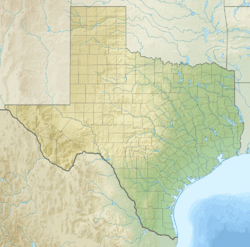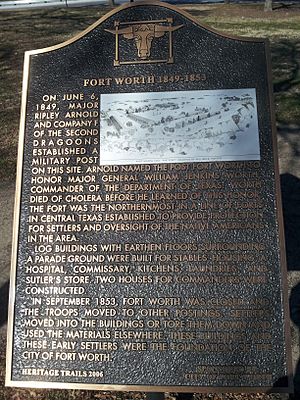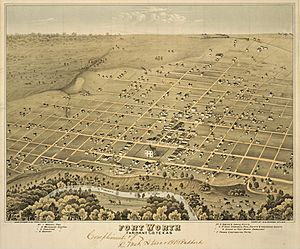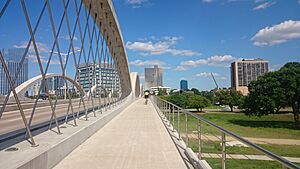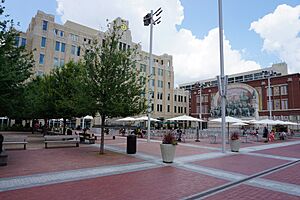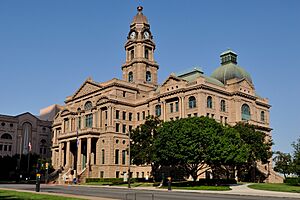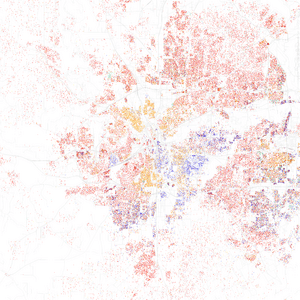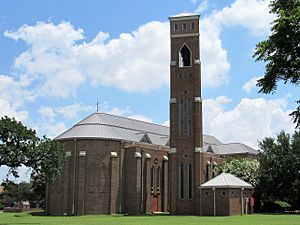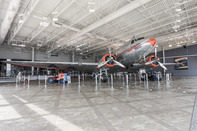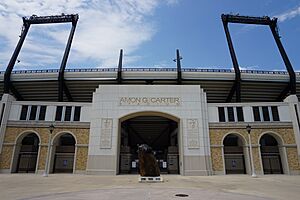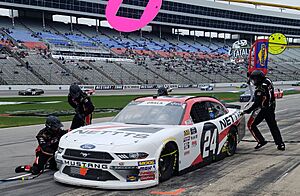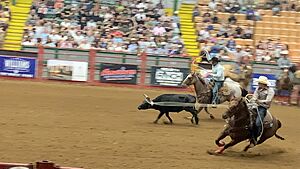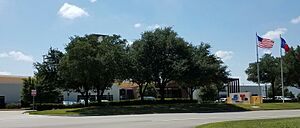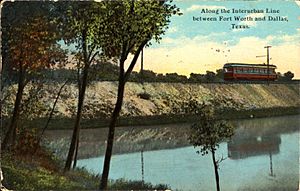Fort Worth, Texas facts for kids
Quick facts for kids
Fort Worth
|
|||
|---|---|---|---|
|
|||
| Nicknames:
Cowtown, Panther City, Funkytown, Queen City of the Prairie
|
|||
| Motto(s):
"Where the West begins"; "Crossroads of Cowboys & Culture"
|
|||
| Country | United States | ||
| State | Texas | ||
| Counties | Tarrant, Denton, Johnson, Parker, Wise | ||
| Incorporated | 1874 | ||
| Named for | William J. Worth | ||
| Government | |||
| • Type | Mayor–council–manager | ||
| Area | |||
| • City | 355.56 sq mi (920.89 km2) | ||
| • Land | 347.27 sq mi (899.44 km2) | ||
| • Water | 8.28 sq mi (21.45 km2) | ||
| Elevation | 541 ft (165 m) | ||
| Population | |||
| • City | 996,756 |
||
| • Rank | 33rd in North America 12th in the United States 5th in Texas |
||
| • Metro | 7,637,387 (US: 4th) | ||
| Demonym(s) | Fort Worthian | ||
| Time zone | UTC−6 (CST) | ||
| • Summer (DST) | UTC−5 (CDT) | ||
| ZIP Codes |
76008, 76036, 761XX, 76244
|
||
| Area codes | 682 and 817 | ||
| FIPS code | 48-27000 | ||
| GNIS feature ID | 2410531 | ||
Fort Worth is a large city in Texas, a state in the United States. It is the main city of Tarrant County. Fort Worth covers about 350 square miles and reaches into other counties like Denton and Johnson.
In 2024, nearly 1 million people lived in Fort Worth. This makes it the fourth-largest city in Texas. It is also the 12th-largest city in the entire United States. Fort Worth is the second-biggest city in the Dallas–Fort Worth metroplex. This metro area is the fourth-largest in the U.S. and the biggest in Texas.
Fort Worth started as an army outpost in 1849. It was built on a hill overlooking the Trinity River. The city was famous for its Texas Longhorn cattle trade. Even today, Fort Worth celebrates its Western history. It has kept its traditional buildings and style. The United States Navy even named a ship, the USS Fort Worth (LCS-3), after the city.
Fort Worth has grown very fast in the 21st century. Its population has almost doubled since the year 2000. It is known for its many museums and the Van Cliburn International Piano Competition. Famous architects designed some of its museums. For example, the Kimbell Art Museum was designed by Louis Kahn. The Modern Art Museum of Fort Worth was designed by Tadao Ando.
Many universities are in Fort Worth. These include Texas Christian University and the University of North Texas Health Science Center. Big companies like American Airlines and Bell Textron also have their main offices here.
Contents
History of Fort Worth
How Fort Worth Started
In 1843, a peace agreement called the Treaty of Bird's Fort was signed. It was between Texas and several Native American tribes. This treaty set up a border where people could not cross without permission. Later, "trading houses" were built at the meeting point of the Clear Fork and West Fork of the Trinity River. This is where Fort Worth is today.
In 1849, the U.S. Army set up Fort Worth. It was one of 10 forts built to protect the American Frontier. This happened after the Mexican–American War. Fort Worth is still known as "where the West begins."
Building the Fort
After the Mexican War, seven army posts were built in Texas. These forts protected settlers along the western frontier. Fort Worth was one of them. Major General William J. Worth first suggested building 10 forts in 1849. He wanted them to mark the western Texas border. Sadly, General Worth died from cholera a month later.
General William S. Harney then took over. He ordered Major Ripley A. Arnold to find a good spot for a new fort. On June 6, 1849, Arnold set up a camp by the Trinity River. He named it Camp Worth, honoring General Worth. In August 1849, the camp moved to a bluff overlooking the river. On November 14, 1849, the U.S. War Department officially named it Fort Worth.
Native American attacks were a concern because this was their land. But settlers from the United States still built homes near the fort. The fort was flooded its first year and moved to higher ground. The current courthouse stands on this spot. The fort was closed on September 17, 1853. No parts of the original fort remain today.
Becoming a Town
Fort Worth was a stop on the famous Chisholm Trail. This trail was used to move millions of cattle north to markets. Because of this, Fort Worth became a busy town. It was the center of the cattle drives and later the ranching business. This is why it earned the nickname "Cowtown."
During the American Civil War, Fort Worth faced many shortages. The population dropped to only about 175 people. But it started to grow again after the war. By 1872, new stores and banks opened. This helped the city recover and grow.
Recent History
On March 28, 2000, a strong tornado hit downtown Fort Worth. It damaged many buildings. One of the hardest-hit was the Bank One Tower. This building was a key part of the Fort Worth skyline. It has since been rebuilt into fancy apartments. This was the first major tornado to hit Fort Worth since the 1940s.
In the early 2000s, Fort Worth was one of the fastest-growing big cities in the U.S. It was even called one of "America's Most Livable Communities."
Fort Worth's Location and Weather
Where is Fort Worth?
Fort Worth is in North Texas. It has a warm, humid climate. The city is part of the Cross Timbers region. This area is where thick forests meet rolling hills and prairies.
The city covers about 349 square miles. Most of this is land, with some areas covered by water. Fort Worth is a main city in the Dallas–Fort Worth metroplex. It is the second-largest city by population in this area.
Fort Worth has many natural gas wells underground. These wells tap into the Barnett Shale. You can find these well sites in different parts of the city.
A large dam was built in 1914 on the West Fork of the Trinity River. This dam created Lake Worth.
Fort Worth Neighborhoods
Downtown Fort Worth
Downtown Fort Worth has many different areas. These include places for shopping, offices, homes, and entertainment. Sundance Square is a popular spot for nightlife and fun. The Bass Performance Hall is also in Sundance Square.
Stockyards
The Fort Worth Stockyards is a very old and important area. It used to be one of the biggest livestock markets in the U.S. It played a big role in the city's early growth. Today, the Stockyards has many restaurants and country music places. Billy Bob's Texas is the world's largest honky tonk and is located here.
You can visit the Stockyards Station mall. A train from the Grapevine Vintage Railroad connects to downtown Grapevine. The Cowtown Coliseum hosts a rodeo every week. It also has the Texas Cowboy Hall of Fame. Fort Worth is the only major city with a daily cattle drive.
Tanglewood
Tanglewood is a neighborhood along the Trinity River. It is about five miles southwest of downtown. This area used to be a dairy farm. Children used to swim in the river where a bridge is now.
Fort Worth Buildings
Downtown Fort Worth is known for its unique, old-fashioned buildings. Many have an Art Deco style. The Tarrant County Courthouse looks like the Texas State Capitol building. Many buildings around Sundance Square have kept their early 1900s look. Several blocks around Sundance Square are lit up with Christmas lights all year.
Fort Worth Weather
Fort Worth has a humid subtropical climate. This means it has very hot, humid summers. Winters are mild to cool. August is the hottest month, with average highs around 96°F (36°C). January is the coldest, with average highs around 56°F (13°C).
The highest temperature ever recorded was 113°F (45°C) in June 1980. The coldest was -8°F (-22°C) in February 1899. Fort Worth can get strong thunderstorms with large hail and tornadoes.
Fort Worth gets about 34 inches (864 mm) of rain each year. May is usually the wettest month. January is the driest. The city gets about 2.6 inches (66 mm) of snow each year.
| Climate data for Fort Worth Meacham International Airport, Texas (1991–2020 normals, extremes 1940–present) | |||||||||||||
|---|---|---|---|---|---|---|---|---|---|---|---|---|---|
| Month | Jan | Feb | Mar | Apr | May | Jun | Jul | Aug | Sep | Oct | Nov | Dec | Year |
| Record high °F (°C) | 88 (31) |
97 (36) |
96 (36) |
102 (39) |
101 (38) |
107 (42) |
112 (44) |
110 (43) |
112 (44) |
106 (41) |
95 (35) |
90 (32) |
112 (44) |
| Mean maximum °F (°C) | 78.1 (25.6) |
81.1 (27.3) |
86.0 (30.0) |
89.5 (31.9) |
95.5 (35.3) |
99.6 (37.6) |
103.6 (39.8) |
104.3 (40.2) |
99.3 (37.4) |
92.7 (33.7) |
83.2 (28.4) |
78.1 (25.6) |
105.7 (40.9) |
| Mean daily maximum °F (°C) | 56.4 (13.6) |
60.5 (15.8) |
68.0 (20.0) |
75.6 (24.2) |
83.5 (28.6) |
91.5 (33.1) |
95.7 (35.4) |
95.9 (35.5) |
88.3 (31.3) |
77.9 (25.5) |
66.2 (19.0) |
57.8 (14.3) |
76.4 (24.7) |
| Daily mean °F (°C) | 45.8 (7.7) |
49.8 (9.9) |
57.3 (14.1) |
64.7 (18.2) |
73.3 (22.9) |
81.4 (27.4) |
85.1 (29.5) |
85.2 (29.6) |
77.7 (25.4) |
66.9 (19.4) |
55.7 (13.2) |
47.5 (8.6) |
65.9 (18.8) |
| Mean daily minimum °F (°C) | 35.3 (1.8) |
39.1 (3.9) |
46.5 (8.1) |
53.8 (12.1) |
63.1 (17.3) |
71.2 (21.8) |
74.6 (23.7) |
74.5 (23.6) |
67.1 (19.5) |
55.9 (13.3) |
45.3 (7.4) |
37.3 (2.9) |
55.3 (12.9) |
| Mean minimum °F (°C) | 19.9 (−6.7) |
23.2 (−4.9) |
28.5 (−1.9) |
37.6 (3.1) |
49.1 (9.5) |
62.0 (16.7) |
68.8 (20.4) |
66.8 (19.3) |
53.9 (12.2) |
39.7 (4.3) |
29.3 (−1.5) |
22.1 (−5.5) |
16.5 (−8.6) |
| Record low °F (°C) | −2 (−19) |
−2 (−19) |
10 (−12) |
28 (−2) |
38 (3) |
52 (11) |
60 (16) |
58 (14) |
40 (4) |
24 (−4) |
19 (−7) |
10 (−12) |
−2 (−19) |
| Average precipitation inches (mm) | 2.05 (52) |
2.41 (61) |
3.16 (80) |
3.06 (78) |
4.02 (102) |
4.02 (102) |
2.18 (55) |
2.23 (57) |
2.59 (66) |
4.46 (113) |
2.52 (64) |
2.64 (67) |
35.34 (898) |
| Average precipitation days | 7.2 | 6.1 | 7.5 | 7.2 | 9.3 | 7.2 | 4.7 | 4.5 | 5.8 | 7.1 | 6.7 | 6.5 | 79.8 |
| Mean monthly sunshine hours | 186.0 | 169.5 | 217.0 | 240.0 | 248.0 | 300.0 | 341.0 | 310.0 | 240.0 | 217.0 | 180.0 | 186.0 | 2,834.5 |
| Percent possible sunshine | 60 | 55 | 58 | 62 | 57 | 71 | 79 | 77 | 67 | 64 | 60 | 60 | 64 |
| Average ultraviolet index | 3 | 5 | 7 | 9 | 10 | 11 | 10 | 10 | 8 | 6 | 4 | 3 | 7 |
| Source 1: National Climatic Data Center | |||||||||||||
| Source 2: Weather Atlas (sunshine data, UV index) | |||||||||||||
People of Fort Worth
| Historical population | |||
|---|---|---|---|
| Census | Pop. | %± | |
| 1880 | 6,663 | — | |
| 1890 | 23,076 | 246.3% | |
| 1900 | 26,668 | 15.6% | |
| 1910 | 73,312 | 174.9% | |
| 1920 | 106,482 | 45.2% | |
| 1930 | 163,447 | 53.5% | |
| 1940 | 177,662 | 8.7% | |
| 1950 | 278,778 | 56.9% | |
| 1960 | 356,268 | 27.8% | |
| 1970 | 393,476 | 10.4% | |
| 1980 | 385,164 | −2.1% | |
| 1990 | 447,619 | 16.2% | |
| 2000 | 534,697 | 19.5% | |
| 2010 | 741,206 | 38.6% | |
| 2020 | 918,915 | 24.0% | |
| 2024 (est.) | 996,756 | 34.5% | |
| U.S. Decennial Census 2010–2020 |
|||
Fort Worth is the largest city in Tarrant County. It is also the second-largest city in the Dallas–Fort Worth metroplex. This large area is home to a quarter of all Texans.
In 2018, Fort Worth had almost 900,000 residents. By 2024, the population was estimated to be nearly 1 million. The city has become very diverse. A study in 2019 called Fort Worth one of the most diverse cities in the U.S.
Different Cultures in Fort Worth
| Racial composition | 2020 | 2010 | 1990 | 1970 | 1940 |
|---|---|---|---|---|---|
| White | 44.9% | 61.6% | 63.8% | 79.4% | 85.7% |
| —Non-Hispanic | 36.6% | 41.7% | 56.5% | 72.0% | n/a |
| Hispanic or Latino (of any race) | 34.8% | 34.1% | 19.5% | 7.9% | n/a |
| Black or African American | 19.2% | 18.9% | 22.0% | 19.9% | 14.2% |
| Asian | 5.1% | 3.7% | 2.0% | 0.1% | - |
In 2018, about 38% of Fort Worth residents were white, not Hispanic. About 18% were Black or African American. About 35% were Hispanic or Latino. This shows how much the city's population has changed.
The Hispanic or Latino population includes many Mexican Americans. There are also people from Puerto Rico and Cuba.
Religions in Fort Worth
Fort Worth is in the Bible Belt, so Christianity is the largest religion. More people in Fort Worth are Protestant than Catholic.
The biggest Christian group in Fort Worth are Baptists (18.1%). The second largest are Catholics (7.1%). Methodists (3.9%) are the third largest group. Other Christian groups include Pentecostals, Latter-day Saints, Lutherans, and Episcopalians.
The oldest church still operating in Fort Worth is First Christian Church, started in 1855. Other old churches include St. Patrick Cathedral (1888) and Saint James Second Street Baptist Church (1895).
About 1.2% of Fort Worth's people are Muslim. The city has several mosques. A small Jewish community also lives here. Other religions like Buddhism, Sikhism, and Hinduism are also present.
Fort Worth's Economy
Fort Worth's economy first grew because of the cattle drives. Millions of cattle were moved north along the Chisholm Trail. Fort Worth became the main center for cattle drives and ranching.
Today, many big companies have their main offices in Fort Worth. These include American Airlines Group, BNSF Railway, and Bell Textron. Other large companies like Bank of America and Lockheed Martin also have a big presence in the city.
Culture and Fun in Fort Worth
Fort Worth is known as the "City of Cowboys and Culture." It celebrates its Western past and has a strong arts scene. The city has the world's first and largest indoor rodeo. It also has many world-class museums and festivals.
Western Swing music was created in Fort Worth in 1931. It was made by Bob Wills and Milton Brown and their band, the Light Crust Doughboys.
Arts and Sciences
- Theatre
- Bass Performance Hall
- Casa Mañana
- Circle Theatre
- Jubilee Theater
- Music
- Billy Bob's
- Fort Worth Opera
- Fort Worth Symphony Orchestra
- Texas Ballet Theater
- Van Cliburn International Piano Competition
- Museums
- American Airline C.R. Smith Museum
- Amon Carter Museum of American Art
- Fort Worth Museum of Science and History
- Fort Worth Stockyards Museum
- Kimbell Art Museum
- Log Cabin Village
- Military Museum of Fort Worth
- Modern Art Museum of Fort Worth
- National Cowgirl Museum and Hall of Fame
- Sid Richardson Museum
- Texas Civil War Museum
- Texas Cowboy Hall of Fame
Nature and Gardens
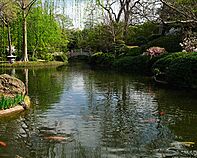
The Fort Worth Zoo is home to over 5,000 animals.
The Fort Worth Botanic Garden is also in the city. For those who like hiking or birdwatching, the Fort Worth Nature Center and Refuge is a great place. It is a large natural area with a small herd of bison. It also has native prairies, forests, and wetlands. It is one of the biggest urban parks of its kind in the U.S.
City Parks
Fort Worth has 263 parks, covering over 11,700 acres.
The Fort Worth Water Gardens is a special park downtown. It was designed by famous architects Philip Johnson and John Burgee. It has three pools of water and green hills. It is called a "cooling oasis in the concrete jungle." Heritage Park Plaza is another park with concrete structures and flowing water.
There are also two off-leash dog parks in the city: ZBonz Dog Park and Fort Woof. They have agility courses and water fountains for dogs.
Sports in Fort Worth
Fort Worth has its own sports identity. The city has a USL Championship soccer club, Austin Bold FC, which moved to Fort Worth in 2021.
College Sports
Texas Christian University (TCU) has the main college sports teams in Fort Worth. Their teams are called the TCU Horned Frogs. They play in NCAA Division I. The Horned Frog football team won two national championships in the 1930s.
Famous TCU football players include Sammy Baugh and LaDainian Tomlinson. The Horned Frogs became a top team under coach Gary Patterson. They won the Rose Bowl in 2011. In 2012, they joined the Big 12 athletic conference.
Texas Wesleyan University also has sports teams. They won the NAIA Div. I Men's Basketball Championship in 2006. Fort Worth also hosts the Lockheed Martin Armed Forces Bowl in college football.
Recreation and Events
Golf Tournament
Fort Worth hosts a major professional men's golf tournament every May. It is held at the Colonial Country Club. This event is very important in the golf world. The Colonial Country Club was the home course of golf legend Ben Hogan, who was from Fort Worth.
Motor Racing
Fort Worth is home to Texas Motor Speedway. This track is known as "The Great American Speedway." It is a 1.5-mile oval track in the northern part of the city. The speedway opened in 1997. It hosts IndyCar and NASCAR races.
Cowtown Marathon
The annual Cowtown Marathon happens every February. It has been held since 1978. This event includes different races, like 5Ks, a 10K, a half marathon, a marathon, and an ultra marathon.
Rodeo Events
Besides the weekly rodeos at Cowtown Coliseum, the Fort Worth Stock Show and Rodeo is a big event. It takes place at the Will Rogers Memorial Center and the Dickies Arena. Dickies Arena also hosts some TCU basketball games.
Education in Fort Worth
Public Libraries
The Fort Worth Public Library system serves the city.
Public Schools
Most of Fort Worth is served by the Fort Worth Independent School District.
Other school districts that serve parts of Fort Worth include:
- Aledo Independent School District
- Azle Independent School District
- Birdville Independent School District
- Burleson Independent School District
- Castleberry Independent School District
- Crowley Independent School District
- Eagle Mountain-Saginaw Independent School District
- Everman Independent School District
- Keller Independent School District
- Lake Worth Independent School District
- Northwest Independent School District
- White Settlement Independent School District
Private Schools
Fort Worth has many private schools. These include both non-religious schools and those connected to churches.
- All Saints' Episcopal School (PreK–12)
- Bethesda Christian School (K–12)
- Fort Worth Christian School (K–12)
- Fort Worth Country Day School (K–12)
- Nolan Catholic High School (9–12)
- Trinity Valley School (K–12)
Colleges and Universities
Fort Worth is home to several colleges and universities:
- Texas Christian University
- Texas Wesleyan University
- University of North Texas Health Science Center
- Texas A&M University School of Law
- Tarleton State University – Fort Worth campus
- Tarrant County College
Media in Fort Worth
Fort Worth and Dallas share the same media market. The city has its own magazine, Fort Worth, Texas Magazine. It shares news about events, fashion, and dining.
Fort Worth has one main daily newspaper, the Fort Worth Star-Telegram. It was started in 1906. This newspaper is popular in the western part of the Dallas–Fort Worth area.
The Fort Worth Weekly is another newspaper. It shares news, event guides, and reviews. The Fort Worth Business Press is a weekly paper about business news. The Fort Worth Report is a daily online news group. It covers local government, business, education, and arts.
Television stations shared with Dallas include:
Radio Stations
Over 33 radio stations are in and around Fort Worth. They play many different types of music and shows.
AM Radio
On the AM dial, you can find talk radio. WBAP 820 and KRLD 1080 are popular talk stations. KTCK 1310 plays sports talk. WBAP used to be a country music station.
There are also several religious stations. KHVN 970 and KGGR 1040 play urban gospel music. KKGM 1630 plays Southern gospel.
Many Spanish-speaking stations serve Fort Worth:
- KDFT 540
- KTNO 620
- KHFX 1140
Some stations play different Asian languages:
- KHSE 700
- KKDA 730
- KTXV 890
FM Radio
KLNO is a radio station licensed to Fort Worth. You can also hear urban music on KBFB 97.9 and KKDA 104.5. Many other music stations are on the FM dial.
College radio stations include KTCU 88.7 and KNTU 88.1. The local NPR station is KERA 90.1. Downtown Fort Worth also has the Texas Country station KFWR 95.9 The Ranch.
Getting Around Fort Worth
Most people in Fort Worth drive cars. But you can also use buses from Trinity Metro. There is also a train service to Dallas called the Trinity Railway Express. Since 2019, you can take the TEXRail train from downtown Fort Worth to Dallas/Fort Worth International Airport.
History of Transport
Old Streetcars
The first streetcar in Fort Worth started in December 1876. It ran from the courthouse to the T&P Depot. By 1890, over 20 companies had streetcar lines. The Northern Texas Traction Company later owned many of these lines. In 1925, they had 84 miles of streetcar tracks. These lines connected downtown Fort Worth to TCU and other areas.
Electric Trains
In the early 1900s, electric interurban railways were popular. Texas had almost 500 miles of these tracks. Most were in the Dallas–Fort Worth area. They ran between Fort Worth and Dallas. The line between Fort Worth and Dallas was 35 miles long. It operated from 1902 to 1934. All electric interurban railways stopped running by 1948.
Modern Transportation
In 2015, about 82% of Fort Worth commuters drove alone to work. About 12% carpooled. Only a small number used public transit, walked, or cycled. Most households in Fort Worth own at least one car.
Roads and Highways
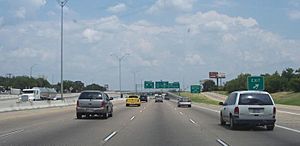
Fort Worth has four interstates and three U.S. highways. These roads help people travel around the city.
- Interstate 30 and Interstate 20 connect Fort Worth to nearby cities like Arlington and Dallas.
- Interstate 35W connects Fort Worth to cities north and south.
- Interstate 820 is a loop that goes around the city.
- U.S. Route 287 runs southeast through the city.
- U.S. Route 377 runs through the city center.
Public Transit Options
Trinity Metro runs bus routes throughout Fort Worth. They also have a downtown bus service called Molly the Trolley. Trinity Metro also serves nearby towns like Blue Mound and River Oaks.
In 2019, Trinity Metro started a new service called ZIPZONE. It offers shared rides on demand. You can book trips using a smartphone app. It helps people connect to trains and buses.
Train Travel
- TEXRail is a train line that opened in 2019. It connects downtown Fort Worth to Dallas/Fort Worth International Airport.
- Trinity Railway Express is a train line that runs between downtown Fort Worth and Dallas.
- Amtrak trains also stop in Fort Worth. These include the Heartland Flyer and Texas Eagle.
Airports
Dallas Fort Worth International Airport (DFW) is a huge airport between Fort Worth and Dallas. It is one of the busiest airports in the world.
Before DFW, Fort Worth had Greater Southwest International Airport. It was the main airport until 1974. Now, the old airport site is a new development.
Fort Worth has four other airports within its city limits:
- Fort Worth Alliance Airport
- Fort Worth Meacham International Airport
- Fort Worth Spinks Airport
- Naval Air Station Joint Reserve Base Fort Worth
Famous People from Fort Worth
Many famous people have come from Fort Worth.
Sister Cities
Fort Worth has "sister cities" around the world. These cities share cultural and economic programs.
See also
 In Spanish: Fort Worth para niños
In Spanish: Fort Worth para niños












